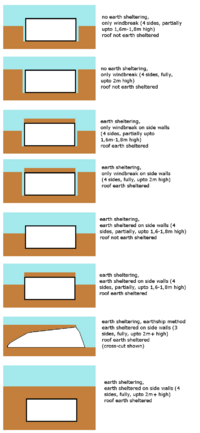No edit summary |
|||
| Line 4: | Line 4: | ||
==Types of windbreaks== | ==Types of windbreaks== | ||
Windbreaks around a house can exist in the form of [[hedge]]s, or walls (stone, soil, ...) | Windbreaks around a house can exist in the form of [[hedge]]s, or walls (stone, soil, ...) | ||
==Advantages and disadvantages== | |||
Earth sheltering can increase the thermal mass of a building. However, in temperate and arctic climates we must make sure that we add a insulation layer. The thickness of this depends on the depth of the soil (see [[Passive solar house]]) If no insulation layer is put in these areas, heat will leak out into the soil at times of the year when the earth cools down. | |||
As most heat tends to leak out via the roof (aswell as via cracks, see Passive solar house) it is best to cover the roof with soil so as to attain maximum efficiency. However | |||
Glass roof | |||
==References== | ==References== | ||
| Line 11: | Line 18: | ||
*[[Passive solar house|Aerodynamics of a house affecting thermal efficiency]] | *[[Passive solar house|Aerodynamics of a house affecting thermal efficiency]] | ||
*[[Earthship]] | *[[Earthship]] | ||
*[[Autonomous houses and neighbourhoods]] | |||
==External links== | ==External links== | ||
Revision as of 12:08, 9 October 2012

Earth sheltering and windbreaks can also reduce the absolute amount of heat needed by a building. Several feet below the earth, temperature ranges from 4°Celsius in North Dakota to 26°Celcius,[1] in Southern Florida. Wind breaks reduce the amount of heat carried away from a building.
Types of windbreaks
Windbreaks around a house can exist in the form of hedges, or walls (stone, soil, ...)
Advantages and disadvantages
Earth sheltering can increase the thermal mass of a building. However, in temperate and arctic climates we must make sure that we add a insulation layer. The thickness of this depends on the depth of the soil (see Passive solar house) If no insulation layer is put in these areas, heat will leak out into the soil at times of the year when the earth cools down.
As most heat tends to leak out via the roof (aswell as via cracks, see Passive solar house) it is best to cover the roof with soil so as to attain maximum efficiency. However
Glass roof
References
See also
External links
- ↑ Stephens, ibid.